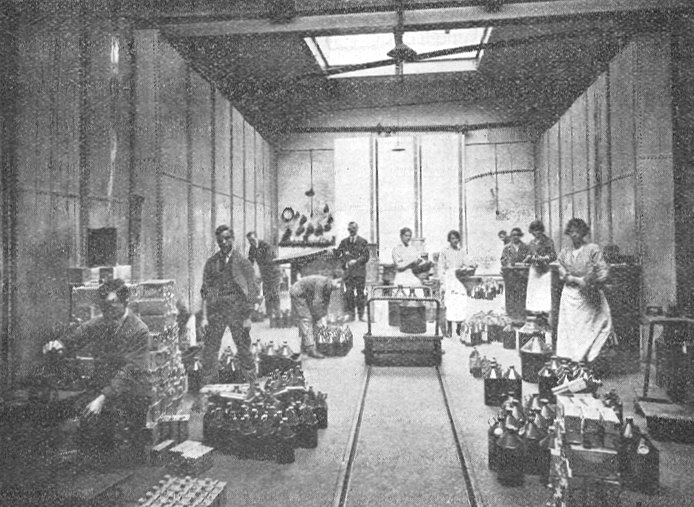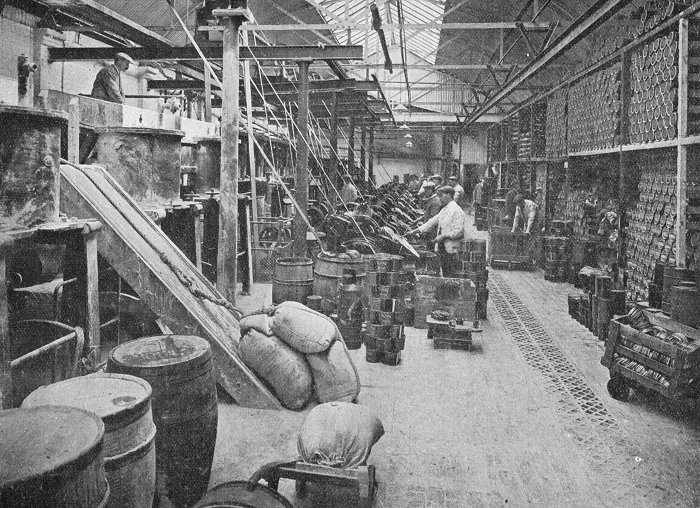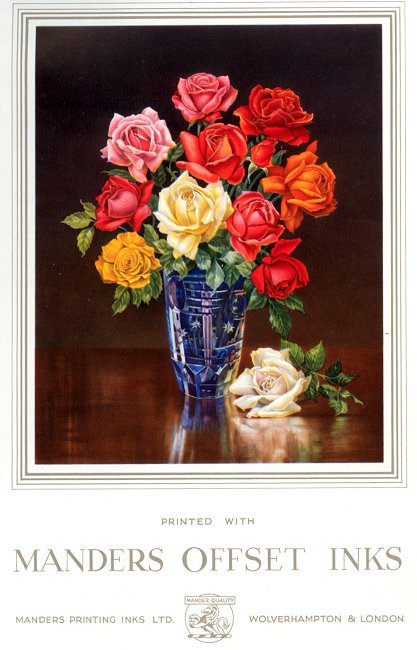|
Charles Bassett's recollections
of his time at Manders. From ‘The Green Can’,
November, 1922.
I entered the service of
the firm at the end of June, 1876. I was not
unacquainted with the high reputation enjoyed by
them; as I had already spent 11 years with
Messrs. Ironmonger and Son, Rope and Twine
Manufacturers, Victoria Street, the retail
premises being now occupied by Messrs. Hudson
and Son. One of the articles manufactured was
wagon covers, therefore a good deal of boiled
oil was used; needless to say, this came from
Messrs. Mander Brothers, as it was the best.
Another incident I remember was that I had to
come and take dimensions for a mat at the foot
of the office stairs, and the late Mr. C. B.
Mander was there to see that I did it correctly.
When I first started, my
work was in the general office, this being the
only one, as the Colour Department was then in
its infancy. During 1878, however, the
department, being a healthy child, and having a
fond parent (the late Mr. Mander J. Smyth) began
to grow vigorously, and I was chosen to assist
Mr. Smyth in the clerical work, devoting a
portion of my time to this duty.
What a small office we had
in which to work! It was practically the same
size as Jack Parry's office in the Warehouse at
the present time. By the time the office
furniture, etc., had found a resting place, and
Mr. Smyth and myself were there too, it might
truthfully be said that we were "full inside."

The Putting-Up
Room in the Varnish Department, John
Street Works. Left to right: Harry
Forrester, O. Dutton, Harry Evans,
A. Barnett, Jack Hughes (in charge),
Edith Phillips, Beattie Davies, D.
Sanders, Ethel Woolley, Annie Eason,
and Lily Rogers. From 'The Green
Can' September, 1922. |
Passing of
The Vine
This state of things,
however, proved to a blessing in disguise. The
panacea for overcrowding is emigration, and
after a time we moved to the Vine Inn, on the
other side of the road, these premises having
been acquired by the firm to meet the growing
need for more room. Here we had two rooms on the
ground floor, Mr. Smyth's I suppose; having been
the bar, and mine the bar parlour. The rooms
overhead were used for putting up stains and
tube colours, and the yard was our first
cooperage.
During these earlier years
the space now occupied by the cycle shed in John
Street presented a very different appearance. It
was here that our first colour-making plant was
erected, and also in an out of the way corner
all kegs were cleaned and painted. Many of us
still remember Henry Smallwood, the chief of
this department, a cheery man with one leg, who
could do as much work as if he had the usual
number.
The next important addition
to the Colour Works was the taking over of St.
Michael's Chapel and Clergy House from the
authorities of St. Peter's Church. In front of
the chapel another building had been erected,
the ground floor of which being used for
parochial work, the overhead rooms being the
abode of the curates. I believe that some very
large grinding stones in the Colour Works Yard
very often disturbed the quiet hours of these
gentlemen.
The Old
Chapel
I well remember when the
chapel floor was re-laid, seeing the immersion
well, which was used at one period, when the
building was used by the Baptists. There was
also a stained glass window, which I think now
adorns St. Peter's Institute. The pulpit was
fixed against the wall, and was reached from the
back of the wall through a doorway. The
galleries were used for the storage of kegs. The
growing needs of the Ink Department soon altered
these conditions, and the basement was used for
ink grinding and the upper floor for a
putting-up warehouse. The ground floor of the
room in front of the chapel was used as the Mess
Room for several years, and the rooms above for
the packing of stains and tube colours, while
the old clergy house adjoining the "Seven Stars"
was used as the Colour Works Office. In the year
1892 the growth of the Colour Works called
loudly for more elbow room, and to meet this
need several acres of land were acquired at
Wednesfield, the position being an admirable
one, the canal being on one side and the Midland
Goods Station on the other. These works were
first started as the "Wednesfield Colour
Company", their chief customer being, of course,
Mander Brothers. The employees at this period
numbered about half a dozen, a
great contrast to the
present pay roll of nearly 120. After a time the
Wednesfield Colour Company was merged in its
powerful rival Mander Brothers, to the mutual
advantage of both.

The Ink
Grinding Mills at Wednesfield Works.
The four men on the right (left to
right) are: Frank Rogers, William
Smith, William Sutton, and Ernest
Dillon. From 'The Green Can'
September, 1922. |
Opening Out
at Wednesfield
As there was now plenty of
room, some departments were transferred to
Wednesfield, among these being the Keg Cleaning
Department and the Cooperage, and others were
started for the first time, one of them being
the manufacture of Varnishes for Ink and Enamel
making, commenced in a small way, but now a very
important branch of the Colour Works. Needless
to say, the Wednesfie1d Works of today covers a
much larger area than originally, in order to
provide for the necessities of Printing Inks,
Water Paints, etc.
Another development
commenced in the year 1899, when the Mander
Hannay Lead Company was started, for manufacture
of Dry White Lead by Professor Hannay's process,
and for this purpose a site was purchased
adjoining the Wednesfield Works. Of course
buildings and plant had to be erected, and
everything connected with the formation of a new
business. I am sure no one can tell better than
our friend Mr. G. G. Harness what this meant, as
he, in conjunction with Mr. Hannay, had the
chief responsibility for the erection of the
plant, etc. This company continued until 1906,
when the business changed hands. The clerical
work was carried on in the Clergy House, the
Colour Works Office having already migrated to
the adjoining Mess Room. I put on record here
that no one was more glad than myself at the
demise of the Mander Hannay Lead Company, as I
had more good thumping headaches during that
period than at any time before or since.

The Water
Paint Grinding Mill at Wednesfield.
Left of the mills, left to right: A.
Martin, W. Murphy, and J. Simmonds.
At the mills left to right: G.
Chester, G. Watkins, H. Lewis, W.
Needham, S. Lloyd, B. Aris, and J.
Gulley. To the right of the mills in
the distance is Tom Lewis, and in
the doorway is W. Kiteley. From 'The
Green Can' November 1922. |
Growth of
Townwell
Bidding Wednesfield goodbye
and good luck, the Colour Making Branch of the
business claims our attention. It soon suffered
from the same complaint as the other
departments, namely, lack of room, and this was
overcome by the purchase of the Factors
Warehouse in Townwell Fold, on which the
Townwell Works, as distinct from the School
Street Works, now stands. In my early days this
warehouse was the property of the old
Wolverhampton firm of Tarratt, Sons and Company,
and I frequently went there in the way of
business. When this property was taken over and
pulled down, one of the things which was saved
was the large double-doored safe which now
adorns the Colour Works General Office, and also
a large office table which also does good
service there. I remember also seeing one of
their old order books dating back to 1815, and
looking through it I found entries for June 7th
and June 9th, but none for June 18th, which was
the day when the battle of Waterloo was fought,
which everyone knows happened on Sunday, June
18th, 1815, and therefore there were no entries
in the book on that date.
Although the accommodation
now allotted to the manufacture of Dry Colours
was considerable, it was soon found to be
insufficient, and in due time this resulted in
the erection of the School Street Works,
covering a much larger area, extending from
Townwell Fold into School Street and Skinner
Street. One of the buildings on this property
was familiar to me in bygone days, being then in
the occupation of Messrs. Ironmonger and Son as
a Sacking and Guano Warehouse, and I believe
that at a much earlier date it was the baths,
and is now used as a stable for the horses. The
activities of Townwell and School Street Works
include a large and well equipped Laboratory,
where experiments are carried on which
constantly result in the production of new
colours, thus enlarging the colour making
output. Here also is the laundry for the washing
of overalls, towels, etc. Collars are not
included, so that the local laundries have no
cause for fear!

The Soldering
Department, Can Works, John Street.
In the centre left to right: Gertie
Lyons, Phyllis Jones, Ethel Davies,
Daisy Beere, Milly Barnett, Jerry
Taylor, and Lily Heath. In the
foreground on the right is Mrs.
Beard. From 'The Green Can' October
1922. |
Specimen
Work
The Specimen Department is
another important branch of the business which
finds a home here, about 16 employees being
engaged in the laudable effort to persuade the
public that the articles produced by Mander
Brothers are the very best of their kind. At
Townwell also, on Christmas Eve, through the
kindness of the firm, a concert has been held
for many years, resulting in much harmony both
of speech and song.
Coming back to John Street,
we note many changes, all for the better. The
first motive power of the Colour Works was
supplied by two large boilers situated nearly
opposite the Varnish Works gateway. These were
eventually taken away, when a gas making plant
was installed at the bottom of John Street, in
the yard adjoining the Mess Room. The steam
engines were therefore supplanted by the gas
engine, which in its turn had to give way to
electricity. The flywheel of the gas engine took
several men to pull over, sometimes to their
discomfort, as they occasionally were "gassed."
Speaking of the John Street
Mess Room, also occupied by Captain Atkins, it
is interesting to note that at one time it was
the General Post Office. "The Vine" premises and
the row of small houses adjoining have long
since been pulled down, making room for the
large block of buildings known as the Tin
Department.
Another change, or rather
loss, was the retirement of the late Mr. Mander
J. Smyth which took place in October, 1905. It
was my privilege to be associated with Mr. Smyth
for a rather longer period than any of my
confreres, and I shall always remember him as
the best of friends. Of all that this business
owes to his personality, it would be impertinent
for me to speak. His portrait adorns. the office
staircase, and it is our pleasure to record that
our manager bears his honoured name.
In 1912 the Clergy House
shared the same fate as "The Vine" and in its
place we see the present important addition to
the Colour Works. With the passing of the Clergy
House arose the necessity for a new abode for
the Colour Works Office Staff, and this was
effected by extensive alterations to Sharlock's
house and other property, including "The Plough"
which, like "The Vine" ceased to be a public
house. The "Seven Stars" below, however, seem to
be as fixed as the stars above.
Worthy
Relics
In our new offices we still
have something to remind us of the past, as Sir
Charles had the fireplace removed to our new
abode, and the Clergy House entrance door also
occupies a similar position in the new offices.
Speaking of office work, I remember that the
late Mr. Mander J. Smyth was the first to
introduce the typewriter for office use. The
first machine we had was a most curious and
inefficient one. I cannot recall its name, which
is well, but I know there was a brass disc with
notches all round, and a handle working from the
centre, and which you dropped into these spaces
(if you could) to make the words required.
Needless to say it was quickly parted with.
| The lady clerk was also a new
departure inaugurated by Mr. Smyth,
and instead of having one, as at
first, we now have 19 of the gentler
sex, largely an increase of recent
years, during which a friendly
rivalry would seem to exist between
Mr. Mortiboy and Mr. Priest as to
which of them should have the larger
staff. I wish to add that both
have their offices at the very top
of the building, although Mr.
Mortiboy is a little nearer the roof
of the two, having to mount another
four or five extra steps, and one
might almost expect to hear the
exultant shout "Excelsior."
In conclusion,
I can only say that the foregoing
remarks show a steady and continuous
growth, which I trust may be
maintained in an even greater
degree, in all departments of the
business, and that the name of
Mander Brothers may stand as high in
the commercial world in the future
as it has done in the past, and
still does at the present time.
|
|

From 'The British
Printer'. |
|
|